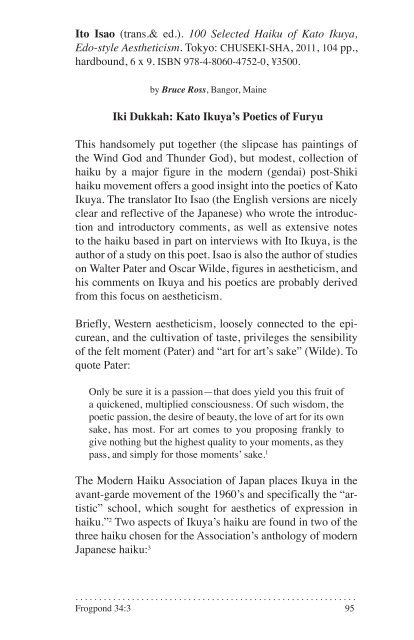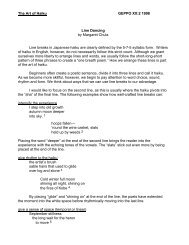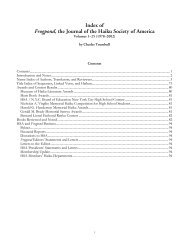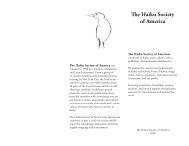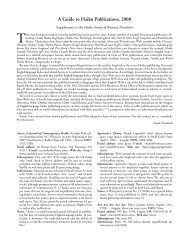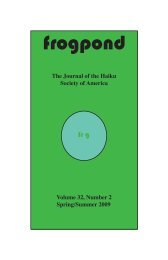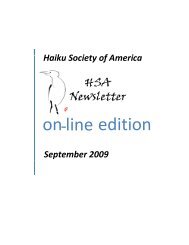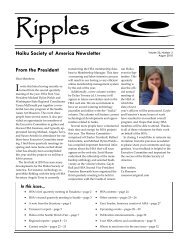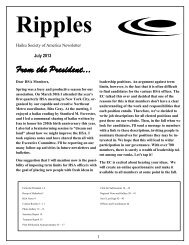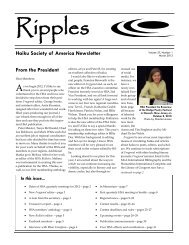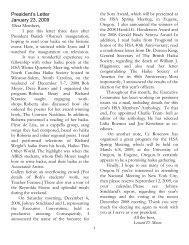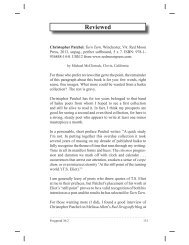Frogpond 34.3 • Autumn 2011 (pdf) - Haiku Society of America
Frogpond 34.3 • Autumn 2011 (pdf) - Haiku Society of America
Frogpond 34.3 • Autumn 2011 (pdf) - Haiku Society of America
You also want an ePaper? Increase the reach of your titles
YUMPU automatically turns print PDFs into web optimized ePapers that Google loves.
Ito Isao (trans.& ed.). 100 Selected <strong>Haiku</strong> <strong>of</strong> Kato Ikuya,<br />
Edo-style Aestheticism. Tokyo: CHUSEKI-SHA, <strong>2011</strong>, 104 pp.,<br />
hardbound, 6 x 9. ISBN 978-4-8060-4752-0, ¥3500.<br />
by Bruce Ross, Bangor, Maine<br />
Iki Dukkah: Kato Ikuya’s Poetics <strong>of</strong> Furyu<br />
This handsomely put together (the slipcase has paintings <strong>of</strong><br />
the Wind God and Thunder God), but modest, collection <strong>of</strong><br />
haiku by a major figure in the modern (gendai) post-Shiki<br />
haiku movement <strong>of</strong>fers a good insight into the poetics <strong>of</strong> Kato<br />
Ikuya. The translator Ito Isao (the English versions are nicely<br />
clear and reflective <strong>of</strong> the Japanese) who wrote the introduction<br />
and introductory comments, as well as extensive notes<br />
to the haiku based in part on interviews with Ito Ikuya, is the<br />
author <strong>of</strong> a study on this poet. Isao is also the author <strong>of</strong> studies<br />
on Walter Pater and Oscar Wilde, figures in aestheticism, and<br />
his comments on Ikuya and his poetics are probably derived<br />
from this focus on aestheticism.<br />
Briefly, Western aestheticism, loosely connected to the epicurean,<br />
and the cultivation <strong>of</strong> taste, privileges the sensibility<br />
<strong>of</strong> the felt moment (Pater) and “art for art’s sake” (Wilde). To<br />
quote Pater:<br />
Only be sure it is a passion—that does yield you this fruit <strong>of</strong><br />
a quickened, multiplied consciousness. Of such wisdom, the<br />
poetic passion, the desire <strong>of</strong> beauty, the love <strong>of</strong> art for its own<br />
sake, has most. For art comes to you proposing frankly to<br />
give nothing but the highest quality to your moments, as they<br />
pass, and simply for those moments’ sake. 1<br />
The Modern <strong>Haiku</strong> Association <strong>of</strong> Japan places Ikuya in the<br />
avant-garde movement <strong>of</strong> the 1960’s and specifically the “artistic”<br />
school, which sought for aesthetics <strong>of</strong> expression in<br />
haiku.” 2 Two aspects <strong>of</strong> Ikuya’s haiku are found in two <strong>of</strong> the<br />
three haiku chosen for the Association’s anthology <strong>of</strong> modern<br />
Japanese haiku: 3<br />
. . . . . . . . . . . . . . . . . . . . . . . . . . . . . . . . . . . . . . . . . . . . . . . . . . . . . . . . . . . .<br />
<strong>Frogpond</strong> 34:3 95


